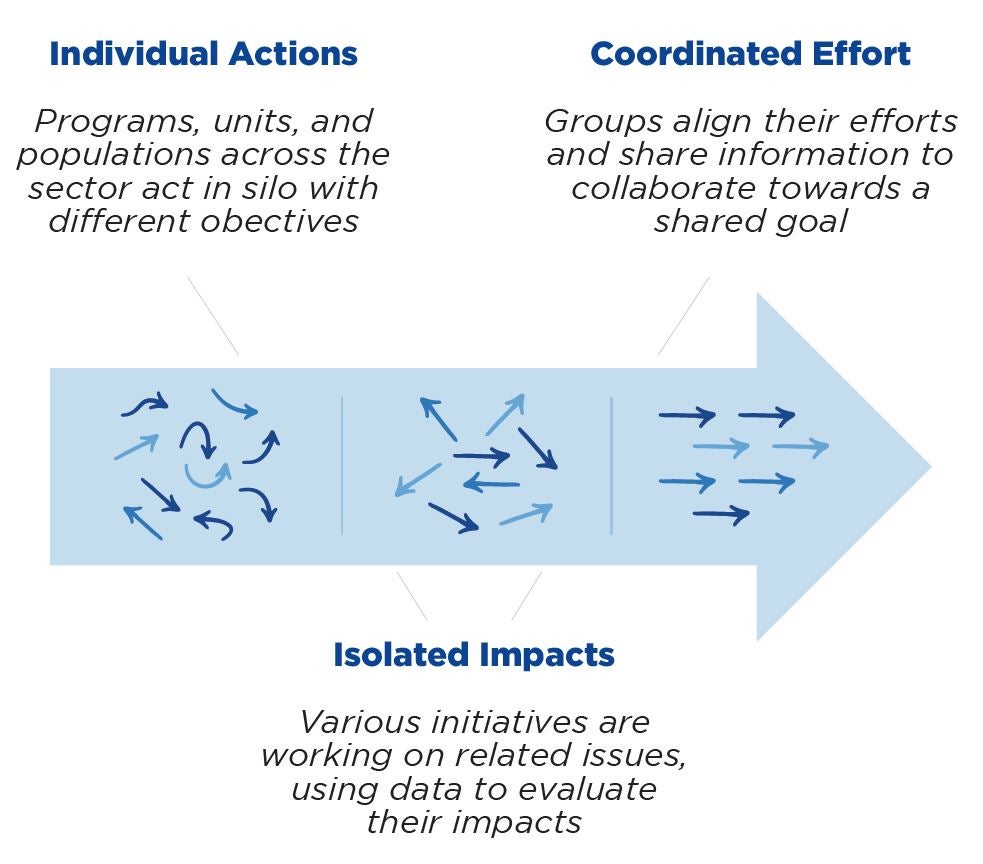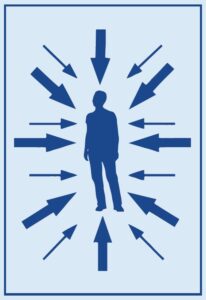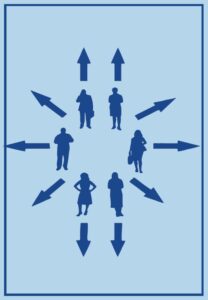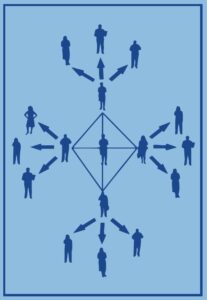Strategic Enrollment and Retention Plan
College of Arts and Sciences 2023-2024 Planning and Implementation Focus is Strategic Retention.
In our SERP we describe our strategic planning and implementation framework, define key concepts, set specific retention goals, and outline our strategic retention priorities.
Introduction
In its Blueprint for Success, Boise State University outlines five major goals, which will guide the institution’s work over the next 5 years. Goal 1, “Improve Educational Access and Student Success,” begins with Strategy 1: “Create and enact a comprehensive, strategic enrollment and student success plan, including components related to supporting the whole student, recruitment, retention, graduation, and addressing performance gaps.”
In Fall 2022, the University launched its Strategic Enrollment and Retention Plan (SERP), which aims to:
- Raise the level of college attainment of Idahoans in general.
- Increase college attendance among those students who are typically less likely to attendcollege in the first place.
- Increase attainment (retention and graduation) among those students typically less likely to graduate.
- Address performance gaps in access and attainment for students
The College of Arts and Sciences is committed to the University’s goal of reducing performance gaps in access, retention, and completion. We recognize the persistence of these gaps as a complex, entrenched problem that requires all units within COAS— and across the university— to align in a common mission and vision and to work collaboratively to improve educational outcomes.
Toward this end, COAS developed our Strategic Enrollment and Retention Plan, which includes a framework for coordinating student success work across the College. The COAS SERP is a living document that will be updated yearly, as we collaborate and make progress towards our shared goals. Our preliminary focus is strategic retention. In our SERP, we describe our strategic planning and implementation framework, define key concepts, set specific retention goals, and outline our strategic retention priorities. In addition, we introduce new COAS-led retention initiatives that officially launched in Fall 2024.
Mission and Vision
COAS SERP Mission
Reduce performance gaps in access, retention, and completion through intentional student support.
COAS SERP Vision
Build a COAS Student Success Network, where COAS units are aligned towards shared goals.
The Collective Impact Framework
Kania and Kramer’s (2011) article “Collective Impact,” published in the Stanford Social Innovation Review, launched a flurry of interest in and conversation around the “Collective Impact Model.”7 The most downloaded article in the history of the Stanford Social Innovation Review, it has more than one million downloads and thousands of academic citations. The article begins by stating a clear but bleak reality: “The scale and complexity of the US public education system has thwarted attempted reforms for decades.” In the Collective Impact approach, intractable problems demand networked solutions. While a single organization or unit can chip away at a large-scale problem, a network of organizations aligned around a common agenda can create transformative and sustainable change. To achieve Collective Impact, a group of leaders across units decide “to abandon their individual agendas in favor of a collective approach to improving student achievement.” This idea of “abandoning their agenda” does not mean that the individual units cast aside their values or compromise their unique contributions; instead, it means that they join an ecosystem rather than working in isolation.
We see an example of Collective Impact at work in higher education at the University of San Diego. Their mission is “to leverage and enhance the disparate mentoring, training, and support systems at UC San Diego that have the potential to jointly improve the experience, climate, and performance for all of our undergraduates, graduate students, staff, and academics.” They depict the idea of “jointly” improving experience, climate, and performance
as a progression from “individualized actions” to “isolated impacts” to “coordinated effort.”

Student support efforts, for example, are often “isolated actions” that exist in separate units. In some cases, cross-unit collaborations allow for some “isolated impacts” to occur. In a Collective Impact approach, the goal is to achieve “coordinated efforts” where all units move in the same direction as they deliver vital forms of student support (“sharing information toward a shared goal”). With shared goals of student support, satisfaction, and self-efficacy, units can “leverage common datasets, tools and assessments” across programs to expand resources and increase access to support. The Collective Impact approach at UC San Diego can be boiled down to “working together more intentionally.”8
Importantly, though, Collective Impact is not simply a synonym for “collaboration.” Collective Impact provides a detailed and distinctive collaborative process that begins when isolated programs with similar missions and goals work to intentionally network their efforts. The process involves five essential conditions, beginning with creating a common agenda to anchor the work.9
The Five Conditions of Collective Impact

- It starts with a common agenda: This means coming together to collectively define the problem and create a shared vision to solve it.
- It establishes shared measurement: That means tracking progress in the same way, allowing for continuous learning and accountability.
- It fosters mutually reinforcing activities: This means integrating the participants’ many different activities to maximize the end result.
- It encourages continuous communications: That means building trust and strengthening relationships
- And it has a strong backbone: This means having a team dedicated to aligning and coordinating the work of the group
The “common agenda” helps to guard against the pervasive force of “siloing” at universities that perpetually draws attention back to the home unit. With a common agenda, stakeholders can focus on the needs of their home unit while also advancing the shared vision of the network. “Shared measurements” and “mutually reinforcing activities” enhance the work of the home unit by increasing access to data, assessments, tools, and strategies. That means, instead of each program inventing in isolation, or gathering and analyzing data in isolation, the work becomes visible and shared across the network. Finally, Collective Impact requires two layers of infrastructure. All Collective Impact efforts must build a system of “continuous communications” across the network that activates consistent (and not burdensome) communication across units. In addition, sustaining the Collective Impact work requires a “strong backbone” with customized support that aligns with the goals (e.g., coordinated research planning and data collection support for the network).
While the idea of networked student support across a unit as large as COAS may seem daunting, the COVID pandemic revealed our capacity for cross-unit innovation and collaboration. As UC San Diego notes, “Our recent experiences dealing with the pandemic have demonstrated that the collective power of our concerted actions amplifies the effect of these individuals’ work.”10 When we embrace a Collective Impact approach, we work more intentionally and efficiently toward our student support goals, and our connections to each other make it easier for students to connect to the resources they need as they navigate their educational journey.
Footnotes
7 Kania & Kramer. (Winter, 2011). Collective Impact. Stanford Social Innovation Review.
8 UC San Diego. (2023). Collective Impact. Regents of the University of California
9 Collective Impact Forum. What is Collective Impact?
10UC San Diego. (2023). Erasing Gaps Using Collective Impact. Regents of the University of California.
The COAS Student Success Network

In a college as large and complex as ours, there is much that we could and should do to support our students and address issues (e.g., advising and mentoring, supportive pedagogies, basic needs and wrap-around services, social and community engagement, career readiness and experiential education, and so on). The question becomes: where do we begin?

In 2022-23, we assembled an Implementation Team of 22 faculty and staff members from across the college to focus on implementation of Student Success and Retention (SSR) strategies. We prioritized the creation of a college-level SERP that would adapt the university-level goals for the complexities of our college. Our process began with an in-depth needs assessment that surfaced the many barriers that disrupt not only student success, but also the success of our faculty and staff. Guided by the goal of closing performance gaps, we must address these barriers and constraints directly in order to design feasible, sustainable strategies. If, for example, a strategy ends up creating an additional burden for a faculty or staff group that is already experiencing burn-out, we have not created a feasible, sustainable strategy for addressing performance gaps.
Coordination and alignment of student success initiatives is challenging and complex. To accomplish this work, we are drawing on existing frameworks for leadership and strategic planning. One of these frameworks, Collective Impact, we have already described at length. The second framework is Marshall Ganz’ “Snowflake” Model of Distributed Leadership. This model is a community organizing strategy where leadership is not held by a single individual or several individuals in charge of isolated initiatives. Rather, leadership is distributed across a network, so that initiatives can be interconnected and aligned.30

Kania et al.’s Collective Impact model31 outlines how distributed leadership might be utilized to combat complex, entrenched social problems. Collective Impact provides a distinctive collaborative process that begins when isolated programs with similar missions and goals work intentionally to align their efforts.
Both the “Snowflake” Model of Distributed Leadership and the Collective Impact model inform how we plan to organize and align student success work across the College.
Footnotes
30Ganz. (Accessed 2023). Organizing: People, Power, Change.
31Kania et al. (2011). Collective Impact. Kania et al. (2022).
Student Success Leadership and Retention Framework
Student Success Leadership Team
COAS Dean, Associate Dean of Education, COAS SERP Lead, Associate Director of Advising, Associate Director of Student Success Initiatives, Director of First-Year Writing, Math Learning Center Director
SERP Priortity Area
Three college-level priority areas for coordinated student support that each contain dedicated leadership, signature strategies, and retention targets
SERP Backbone
Customized infrastructure designed to remove barriers and reach our SERP goals. Backbone support is available to stakeholders across the network
Retention Strategies
Data-informed initiatives with clear targets that will be tracked, assessed, and reported on
Backbone Support
The SSR Implementation Team, in collaboration with the Student Success Leadership Team, will support strategic retention initiatives, with a focus on identifying and building the infrastructure needed to sustain these initiatives and achieve our retention goals. The Backbone also plays a crucial role in ensuring that all members of our community—students, faculty, and staff—have a voice in SERP implementation.
Student Success and Retention Implementation Team Membership
Fall 2023 – Spring 2024
- Casey Iezzi
- Clay Cox
- Cynthia Campbell
- Dan Scott
- David Brandt
- Debra Purdy
- John Bieter
- Jon Schneider
- Jose Lee-Perez
- Karen Viskupic
- Kathrine Johnson
- Kelly Myers
- Manda Hicks
- Nancy Tacke
- Nico Diaz
- Nicole Brun-Mercer
- Sarah Dalrymple
- Jason Herbeck
- Megan Gambs
- Kimberly Henderson
Fall 2022 – Spring 2023
- Casey Iezzi
- Clay Cox
- Eric Landrum
- Jason Herbeck
- John Bieter
- Jon Schneider
- Joseph Low
- Karen Viskupic
- Kelly Myers
- Kimberly Henderson
- Kristin Snopkowski
- Larissa Samson
- Lori Gray
- Manda Hicks
- Melanie Jones
- Melissa Keith
- Michael Kreiter
- Nancy Tacke
- Nico Diaz
- Nicole Brun-Mercer
- Sarah Dalrymple
- Beverly Sherman
- Debra Purdy
- Kathrine Johnson
The SSR Implementation Team has established four working groups that will focus on key areas of Backbone Support. These working groups include:
Faculty and Staff SERP Advisory Board
This team focuses on assessing the structures that either support or impede faculty and staff as they work to help students navigate their path to graduation. Two key questions guide this work: (1) How do we recognize and address burnout? (2) How do we make visible and reward faculty/ staff student success efforts?
Advising Network
The COAS Advising Network assembles a team of stakeholders from across the college (faculty, staff, and students) to help the COAS team identify and prioritize college-level advising strengths, needs, and challenges.
COAS SERP Data Team
This team provides COAS units with research support, with a focus on data access and data-informed decision-making. The Data Team will assess department data needs, lead data walks, and model how data can be used to design targeted interventions and assess impact.
COAS Student Leadership
The COAS Student Success Team formed a partnership with our COAS ASBSU representatives. Through monthly meetings, we share updates from the college and from ASBSU, and we work on dedicated projects. Our first project focuses on gathering student perspectives on advising experiences and needs.